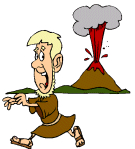
Volcanoes
 Volcanic eruptions are one of the few natural things that can have a diminishing effect on the ozone layer. Large eruptions can potentially inject significant quantities of chlorine (via hydrochloric acid - HCl) directly in the stratosphere where the highest concentrations of ozone are found. However, the vast majority of volcanic eruptions are too weak to reach the stratosphere, beginning approximately 12 km above the Earth's surface. Thus, any HCl emitted during a smaller eruption remains in the lowest atmosphere where it is quickly dissolved and washed out by rain. In contrast man-made CFCs do not dissolve in water and can therefore reach the stratosphere through atmospheric mixing.
Volcanic eruptions are one of the few natural things that can have a diminishing effect on the ozone layer. Large eruptions can potentially inject significant quantities of chlorine (via hydrochloric acid - HCl) directly in the stratosphere where the highest concentrations of ozone are found. However, the vast majority of volcanic eruptions are too weak to reach the stratosphere, beginning approximately 12 km above the Earth's surface. Thus, any HCl emitted during a smaller eruption remains in the lowest atmosphere where it is quickly dissolved and washed out by rain. In contrast man-made CFCs do not dissolve in water and can therefore reach the stratosphere through atmospheric mixing.
It is also possible that ice particles containing sulphuric acid from large volcanic eruptions may contribute to ozone loss. When chlorine compounds resulting from the breakup of man-made CFCs in the stratosphere are present, the sulphate particles serve to convert them into more active forms that may cause more rapid ozone depletion. In 1991 Mt. Pinatubo in the Philippines erupted tonnes of dust and gas high into the atmosphere which caused global reductions in the ozone layer for 2 to 3 years. Thus, whilst large volcanic eruptions may increase the rate of stratospheric ozone depletion, it is more probable that the presence of chlorine from man-made CFC emissions is the chief cause of ozone loss in the first instance.
Websites
Other topics
• Ozone Depletion
• US EPA
• US EPA
• Introduction
• Antarctica
• Arctic
• Causes
• CFCs
• Doing Our Bit
• Evidence
• Eye Disorders
• Global Climate
• Human Health
• Immune System
• Impacts
• Land Plants
• Legislation
• Materials Damage
• Measuring
• Monitoring
• Montreal Protocol
• ODCs
• Ozone
• Ozone Hole
• Ozone Layer
• Polar Vortex
• Protection
• PSCs
• Sea Life
• Skin Cancer
• Stratosphere
• Sun
• UV Radiation
• Volcanoes
 Print Topic
Print Topic